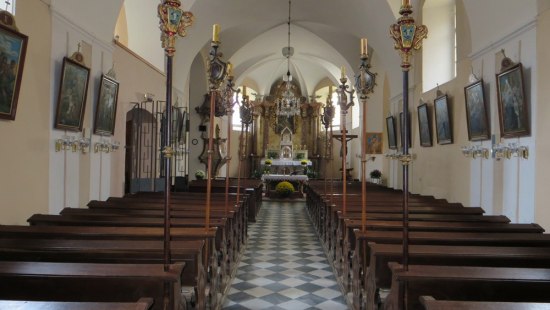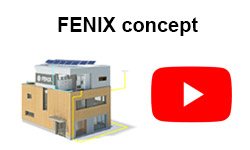Church of St. Gotthard, BOUZOV

Comparison of heating panels: FRICO SH250 and ECOSUN K+
On 16.10.2013 at the Church of St. Gotthard a test was carried out to evaluate radiant heating panels intended for the heating of church pews. The aim was to determine how panels from various manufacturers affect the thermal comfort of churchgoers, thus enabling the most suitable pew-heating system to be chosen.
Description of the application
For many years the pews in the Church of St. Gotthard have been heated using heating rods under the seats. These devices are composed of steel tubes with an inserted electric resistance cable with ceramic "beads".
These heating rods are approximately 2.5m long and their total wattage is approx. 800W. Originally, the heating rods were covered with protective grilles, but as time went by, many of these grilles were knocked off – thus, when the visitors "knelt down" in the pews during prayers, their feet came into contact with the heating elements. It was therefore proposed that the existing devices be replaced with new FRICO SH250 heating panels as part of reconstruction work at the church.
The test procedure
FENIX, as a producer of its own heating panels for such applications, designed and carried out tests comparing FRICO SH panels with their own ECOSUN K+ panels. A FRICO SH250 (250W/230V; 1m long element) was borrowed for testing purposes. In accordance with the instructions as well as the design project, the panel was placed under the seat of the bench in the location of the original heating rod.
An ECOSUN K+ 330 panel (330W/230V; 1.25 m long element) was installed on another pew. The ECOSUN panel has a higher wattage, but is also longer, and the calculated wattage per metre is 264 W/m – i.e. only 14 W higher than that of the FRICO panel.
Both panels and one section of the existing heating system were switched on. After one hour of running without interruption, the warming of the heating elements was measured with the aid of an infrared camera. Simultaneously, the subjective feeling of thermal comfort was evaluated by the individual participants in the test. The test was carried out at an air temperature of approx. 12°C.
The FRICO panel
has a surprisingly long warm-up period. Despite its significantly (several times) higher wattage per square metre, the warm-up period is basically the same as that of the ECOSUN K+ panel.
The surface temperature of the heating rod (a U-shaped rod) exceeds 200°C. Due to its coverage by a metal sheet with a low proportion of openings (the surface area of the slits is smaller than the surface area of the sheet they are cut from!), the average temperature is only 80°C and this only applies to a relatively small area of the heating element (only the cover of the heating element). The sheet metal lamellas at the sides, which probably function as directional reflectors, have a significantly lower temperature. The intensity of radiation is thus only slightly higher than in the case of the ECOSUN K+ panel (thanks to the radiation of the heating rod through openings in the covering metal sheet), but this is directed onto a significantly smaller surface area than in the case of the ECOSUN K+ panel.
Because the panel utilizes the principle of radiation, the heat flow is well perceptible in the upright direction towards the panel. However, the panel is turned towards the floor (a wooden plank floor in this case) and thus the subjective feeling of warmth practically equals zero when a person is sitting on the bench. Only the minor component of heat transferred via convection can be lightly perceived. If these heaters were installed under all the benches, the situation would probably improve somewhat (the convection component would increase due to the presence of more sources). Paradoxically, the system currently used at the church exhibits better parameters, but only because the heating rods used emit no radiant heat, transferring all heat via convection – this appears to be an advantage when the source of heat is placed under the bench.
FRICO panels would probably achieve better parameters if they were turned directly towards the user, thus enabling the radiant heat component to be utilized in a better way. However, this is not possible with regards to the dimensions of the heater and the space between the benches. The visible placement of the heater must also be considered from the aesthetic point of view.
The ECOSUN K+ panel
The average surface temperature of the ECOSUN K+ panel was lower by approx. 70°C, but this was over a significantly larger surface area. Due to its placement on the back rest, allowing the radiant heat to be aimed directly towards the user, it provided the greatest improvement in thermal comfort of all the three systems – the subjective feeling of warming was very clearly perceivable here. A disadvantage of ECOSUN K+ panels is the slight reduction in the amount of room between the benches if the panels are fitted. As the distance between the back rests ranges between 60-70cm, it could be somewhat limiting for taller people, particularly in narrower rows.
Price is also an important aspect - ECOSUN K+ panels are almost 50% cheaper for the same wattage. For 82 pieces, the difference in acquisition price is not negligible and the ECOSUN K+ panel also displayed better operating parameters in the test.
Original heating element
The original heating rods are manufactured from steel tubes into which electric resistance cables with ceramic “beads” have been inserted. They are (were) fitted with covers. In the case of these heaters, warmth is conveyed exclusively via convection.
Even though ECOSUN K+ panels had significantly better operating parameters during the test, the means by which they were attached (always on the rear part of the back support of the preceding pew) was shown to be unsuitable here. The space between the individual pews was relatively narrow, and it would get even smaller after the installation of the panels. Therefore, a third solution was found in the end – you can find more details about the implementation of this application here.













